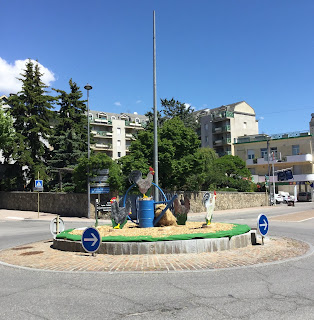If I’m headed eastward into a rising sun to start the day, I’ll opt for a baseball cap rather than helmet taking advantage of the cap’s visor to shield my eyes from the low sun. My helmet has the luxury of resting atop my tent and sleeping bag, with its strap looped through the bungee cords holding down my gear atop the rear panniers, letting it have a view of the scenery behind.
A couple mornings before my arrival in Cannes I somehow managed to forgot my helmet laying in the brush of my campsite in the woods. I didn’t realize my oversight until I stopped to fill my water bottles at a cemetery fifteen miles down the road. The thirty miles to retrieve it was too much, as I had no time to spare to arrive in Cannes in time to meet up with Ralph and the gentleman renting us his apartment.
Rather than berating myself or feeling anger and despair about losing my helmet, the recent gift of a friend, I was confident that whoever it is that ensures the well-being of touring cyclists would look after it until I could return for it in what would be eighteen days. It wasn't a tough task, as I’d left it in an isolated enough area that it wasn’t likely that anyone would stumble upon it.
I couldn’t directly head to it, as first I had to go to Nice, twenty miles in the opposite direction, for the exhibit on the Yellow Jersey at the National Museum of Sport. From there it was a little over a hundred miles to the helmet. I had hoped to camp once again where I’d left it the next day, but the mistral had kicked up and held me back.
I hadn’t only missed it as my head covering, but also as a protective receptacle in a corner of my tent for my watch and glasses during my sleeping hours. The tent had seemed empty without it. All was now well in my world.
We weren’t the only ones heading into the Alps. There were brief spurts of convoys of small sports cars on communal drives, not an uncommon site on the scenic roads of France. Groups in vintage cars or Deux Chevaux like to drive en masse. Motorcyclists too, often with German plates. Clusters of cyclists too are drawn to the spectacular riding in the Alps. The French identify themselves with their strong cologne and their array of words of endorsement and encouragement—“Bravo” and “Chapeau” and “Respect” and “Allée” and “Courage” and “Oh la-la.” English may have twice the number of words as French, but it lacks an equivalent to any of these, or at least the spirit. It is in the French nature to respond favorably to someone doing something they like, such as with “Bon appetite” to anyone they see eating.
The return to my helmet allowed me to approach the Alps on a more gentle route up a valley to Gap rather than tackling them head on from Nice. Gap would be the Ville Arrivée on the stage originating at the Pont Du Gard, that I visited on the way to Cannes. Gap is such a frequent Ville Étape there were no banners or decorations mounted yet, not even at the usual finish line across from a small park and museum not far from the center of this city of 42,000.
The next day’s stage starting in Embrun twenty-five miles away deeper into the mountainous terrain also had yet to decorate itself for The Tour, as it too had been featured in The Tour every two or three years of late.
The climbing got serious after Embrun to Briançon, the highest city in France, and then a sixteen-mile climb to the Col du Lautaret and the turn to the mighty Galibier. I planned to stay at the Deux Glaciers campground half-way up the climb to be relatively fresh for the Galibier the next day and for my first shower since Cannes and first chance to get my iPad up to 100 per cent and to do some wash and have WIFI to give Janina a call, but when I arrived at the campground at seven p.m. I discovered it hadn’t opened for the season yet despite the great amount of traffic.
It was lucky I had filled my water bottles fifteen minutes before just in case I saw a forest I couldn’t resist. The campground was fenced in but it was easy to disappear into the bush beside a small nearby lake for much superior camping than the campground would have provided, other than the amenities I generally do without—hot water, electricity and WIFI.















